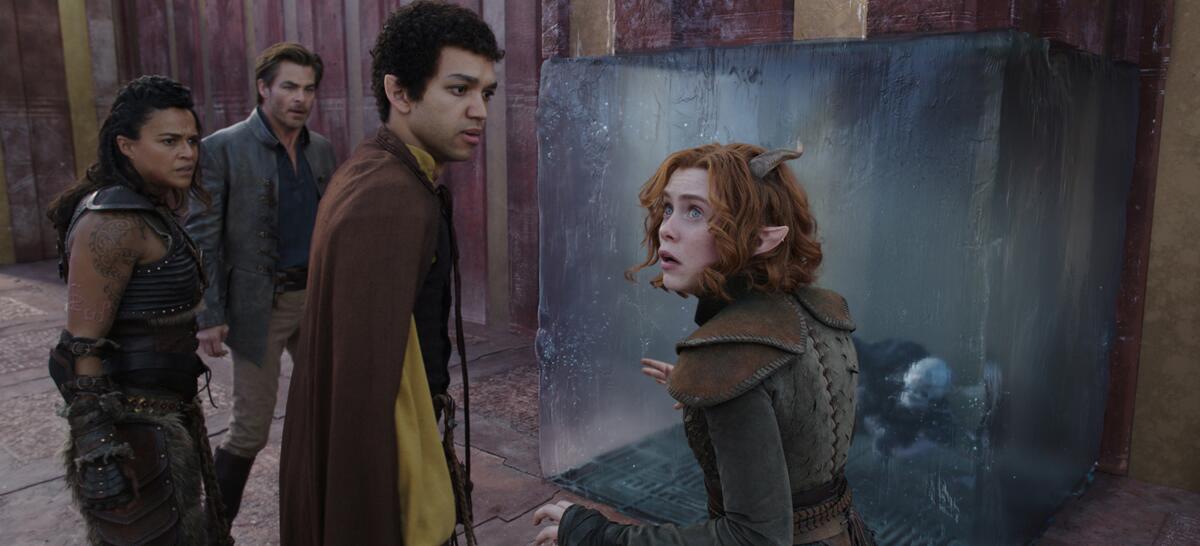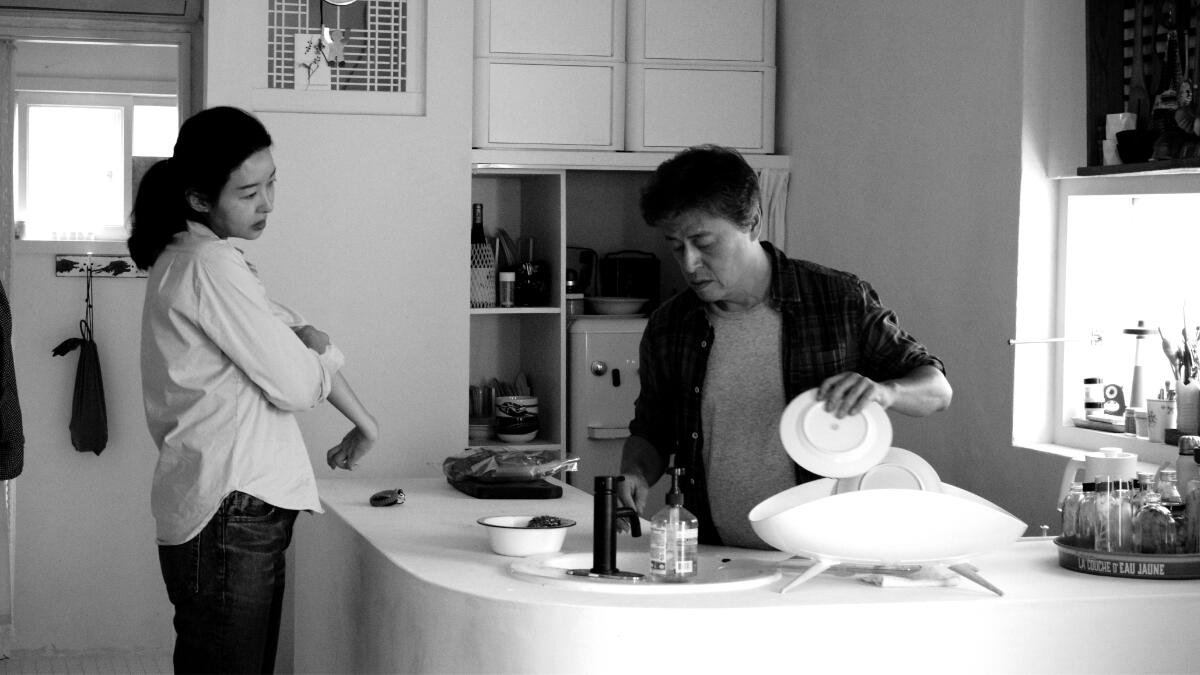Portrait of a family and a city in ‘A Thousand and One’

- Share via
Hello! I’m Mark Olsen. Welcome to another edition of your regular field guide to a world of Only Good Movies.
Only good movies
Get the Indie Focus newsletter, Mark Olsen's weekly guide to the world of cinema.
You may occasionally receive promotional content from the Los Angeles Times.
Beth B up from the underground. Filmmaker Beth B has been a part of the New York City underground art and film scene going back to the 1970s, making works that convey a sense of time and place with vitality. The American Cinematheque and the UCLA Film and Television Archive are putting on a joint retrospective April 1-8. Titles include “Exposed,” “Two Small Bodies” and “Lydia Lunch: The War Is Never Over” at the Cinematheque and “The Offenders,” “Vortex,” “The Dominatrix Sleeps Tonight” and “Salvation! Have You Said Your Prayers Today?” at UCLA.
New horror at the New Bev. Two of my favorite (realtively) recent horror movies will play as a double bill at the New Beverly April 3-4. Ti West’s 2009 “House of the Devil” has fun with the fear of satanic cults that took hold in the 1980s, feeling both retro and contemporary with a cast that includes Jocelin Donahue, Greta Gerwig, Tom Noonan, Mary Woronov and Dee Wallace. In Adam Wingard’s 2011 “You’re Next,” a dysfunctional family reunion turns into a fight for survival when masked killers arrive at the door and the body count quickly rises. Sharni Vinson stars alongside a cast including filmmakers Amy Seimetz, Joe Swanberg, Larry Fessenden and, look at that, Ti West.
Enjoying this newsletter? Consider subscribing to the Los Angeles Times
Your support helps us deliver the news that matters most. Become a subscriber.
‘A Thousand and One’
The feature debut for writer-director A.V. Rockwell, “A Thousand And One” won the U.S. dramatic grand jury prize at this year’s Sundance Film Festival. With a powerful lead performance by Teyana Taylor, the story follows Inez (Taylor) as she tries to hold together a semblance of stability for herself and her son Terry (played by three actors at three different ages) as New York City changes around them. The film is in theaters now.
For Tribune News Service, Katie Walsh wrote, “The film is utterly absorbing, anchored by the unpredictable performance of Taylor, playing a hopelessly complicated, but deeply caring woman. When faced with dire circumstances, she survives, then dares to imagine a life for Terry beyond the cycle she’s experienced, forging a family unit she never had. ... ‘A Thousand and One’ is a fascinating portrait of the maternal, feminine instinct caught in an unforgiving world. Taylor’s Inez, possessed of a hard-bitten skill for self-preservation, stays one step ahead, constantly moving forward, a soft shred of hope her only cold comfort.”
Sonaiya Kelley spoke to Rockwell and Taylor about the film and its portrait of a changing city. As Rockwell said, “I always saw this movie as bigger than gentrification. I’m talking about the way a city changed at the turn of the century. That version of New York that you see: that mom-and-pop, super dense, vibrant, colorful city. ... New York became the mecca under that grid when it was a place that was designed for people to experience. Now we’re changing to a city that is way more gray, way more chain stores. It’s like, is it really worth it? Is it worth it to lose all of these icons that make this a specific place?”
For the New York Times, Manohla Dargis wrote, “What interests Rockwell are the lives in the apartments and how these lives joyfully and chaotically flow back and forth into the streets, pumping energy into the city, enlivening and sustaining it. … She knows New York, and she wants you to know (and feel) it, too. She has a documentarian’s sense of place, and while she shows the grime and the mess, she also finds the beauty — and the poignant history — in how the city’s jagged, kaleidoscopic parts restlessly fit together to make a vibrant whole.”
For the Playlist, Robert Daniels wrote, “While ‘A Thousand and One’ is a breathtakingly beautiful portrait of Black womanhood and is thoughtfully political, the character beats heave with a noticeable unevenness. The fascinating parts rarely add up to a satisfying interpersonal whole. Still, as a story of a time and place, as a narrative about how Harlem changed over time and how those brutal transformations affected the most vulnerable, Rockwell’s vision is commendable, if not relatively successful.”
For Rolling Stone, David Fear wrote, “There’s a defensiveness and a mother-lion fierceness to [Inez], as she fights to get shelter and stability in a volatile situation. Yet she seems to soften even as time and circumstances, not to mention setbacks, harden her resolve. That’s Taylor’s doing. Ditto the readings of lines that might have seemed like platitudes on the page but get laced with desperation, sorrow, and years of hard-won victory in her hands. The way she tells Terry to ‘get a plate’ for a former romantic rival of hers during a funeral could be a short story unto itself. … Yet it’s not an easy film to summarize, reduce to political point-scoring soundbites, or dismiss. ‘A Thousand and One’ suggests that the number of narratives of struggle and sacrifice and systematic obstacles are legion. Yet you don’t have to view them cumulatively to realize that every single one of these lives matter and every single one of these stories count.”
For Deadline, Valerie Complex wrote, “‘A Thousand and One’ is a character study that focuses on individuals looking for redemption, and consistency, but poverty and crime prevent them from reaching that goal. … [The film] is a love letter to mothers, sons, daughters, the poor, displaced and the hustlers of NYC. You have to live it to be it. That’s just the New York way.”

‘Dungeons and Dragons: Honor Among Thieves’
Directed by Jonathan Goldstein and John Francis Daley, who co-wrote the script with Michael Gilio, “Dungeons and Dragons: Honor Among Thieves” is an adaptation of the role-playing game beloved by generations for its nerd-friendly immersion and arcana. With a cast that includes Chris Pine, Michelle Rodriguez, Regé-Jean Page, Justice Smith, Sophia Lillis and Hugh Grant, the story finds a band of adventurers coming together for a quest of shifting goals. The films is in theaters now.
For Tribune News Service, Katie Walsh wrote, “The film’s affable nature and the sheer charisma oozing off Pine and Grant is intoxicating, but overall, there’s a sense that it doesn’t quite gel, the engine revving but never hitting the speed of which it seems capable. Daley and Goldstein make for fine dungeon masters; the film is an unapologetically big, fun, swashbuckling slice of hardcore fantasy and leans into that without any self-deprecation, which is the core lesson for our merry band of misfits. And yet there is some ineffable quality lacking — perhaps an emulsifying ingredient — that prevents all these elements (the stars, the lore, the creatures) from coming together into something truly magical. Maybe on the next roll of the 20-sided die.”
Tracy Brown explored how the movie mimics the pleasures of the original game, talking to Goldstein, Daley and Lillis. “We wanted to make sure the movie captured that spontaneity, the collaboration, the unpredictability, and that need to kind of pivot when things turn against you, as they inevitably do,” said Goldstein.
Daley added, “That sense of heartfelt-ness and the lack of cynicism was really important to us. … And I think that there’s a way to be humorous without at all undermining the stakes, or the sincerity” of the adventure.
Brian Contreras took a look at the long road of bringing a Dungeons and Dragons movie back to the screen after previous failed attempts. As Hasbro Chief Executive Chris Cocks said, “The biggest lesson probably from something like the 2000 movie is: Don’t make it just for the fans. Make sure that you tell a story that, even if you’ve never picked up a dice before or read one of the D&D books, you can relate to.”
For the New York Times, Amy Nicholson wrote, “The film, produced in part by Hasbro, makes no direct reference to the actual game outside the frame. Yet its mechanics are felt in ways both affectionate and sarcastic. … For a film about collaboration, the actors aren’t in tonal agreement about the movie they’re in. Grant’s commitment to his dastardly rogue barely goes beyond his cravat — he’d rather guffaw than feign gravitas. By the time a multiple Oscar nominee cameos in a scene played like a Noah Baumbach marital drama, you might wonder if these personality swings are the point? Now that fantasy adventures aren’t dweebs-only, there’s room at the table for all types.”

‘Walk Up’
Written and directed by Hong Sang-soo, “Walk Up” finds the South Korean filmmaker again playing with structure, following a filmmaker, Byung-soo (Kwon Hae-hyo), as he encounters different people in a three-story apartment building. The film is in theaters now.
For The Times, Justin Chang wrote, “The fleeting nature of relationships and the slippery parameters of (fictional) reality are hardly new thematic concerns for Hong, as his many admirers will know. But while some familiarity with his enormous, ever-expanding body of work certainly enriches the experience (this is his 28th feature in 26 years), I suspect that ‘Walk Up’ might play especially well to the uninitiated. The movie, exquisitely shot in black-and-white and unspooling in Hong’s preferred serio-comic idiom of long, boozy meals and funny-sad chatter, is a triptych of tales set in a three-floor walk-up (“three stories” pun hopefully very much intended). If that sounds dull or confusing, it isn’t: ‘Walk Up’ flows as absorbingly as a dream and is no less pleasurable to puzzle over afterward.”
For Vulture, Alison Willmore wrote, “For all of ‘Walk Up’s’ delicious skewering of Byung-soo’s vanity and dread, the film is fueled by an awareness of the precarity of being an artist and the need to earn money that affects all the characters. … . Most of the recurring motifs in ‘Walk Up,’ from mentions of Byung-soo’s beloved Mini Cooper to a romanticization of life overseas to the repeated talk of moving to Jeju Island, have to do with getting away. This makes the building the movie can’t seem to escape from seem all the more like purgatory, though the movie is buoyant and wry enough never to get bogged down by its main character’s flashes of dark panic.”
For Variety, Jessica Kiang wrote, “If ever you’ve glanced into lit-up living rooms while driving down a suburban street at dusk, or glimpsed a neighbor’s apartment over their shoulder when you drop off a package, and found yourself idly wondering not just what the inhabitants’ lives are like, but what maybe your life would be like if you occupied those exotic domestic spaces — well, has mischievous Korean miniaturist Hong Sangsoo made a movie for you. ‘Walk Up,’ the festival darling’s latest benignly sozzled, black-and-white delight, daydreams around that idea, its gentle profundity smuggled in under cover of multilevel playfulness. The movie is a play on time, on imaginative shoestring filmmaking, and on Hong’s own persona. It’s even a play on words, with its three stories sprouting out from each other over three separate stories of the same Seoul walk-up.”

Only good movies
Get the Indie Focus newsletter, Mark Olsen's weekly guide to the world of cinema.
You may occasionally receive promotional content from the Los Angeles Times.




